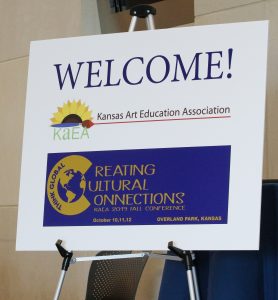
Last week, the Nerman Museum of Contemporary Art hosted the largest Kansas Art Education Association (KAEA) Fall Conference in five years. The conference, entitled Creating Cultural Connections, took place from Thursday, October 10 through Saturday, October 12 and was an unprecedented and enormous undertaking which took 22 months of planning and preparation.
According to Karen Gerety Folk, founding Curator of Education at the museum, the college successfully facilitated over 60 art education sessions. Gerety Folk hosted the event alongside Wendy Ping, both of whom have served on the KAEA board recently. Ping is a youth class instructor at the Nerman Museum and is an art teacher in DeSoto. Gerety Folk has been a member of the KAEA for 16 years, but this is her first time organizing and hosting the event.
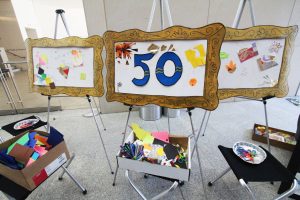
“Wendy Ping and I volunteered to host. This is the third time it has been in the metro area since I have been working here at [the college], and we wanted to get our local teachers excited about the organization again,” Gerety Folk said. “Our local team included teachers from DeSoto, Blue Valley, Olathe and Shawnee Mission districts as well as a retired Olathe teacher who has been volunteering with the Nerman for many years.”
This year, Gerety Folk’s role was different and innovative changes yielded positive results, contributing to the success of the event.
“We decided to try a different planning schedule and make other efforts to be more inclusive by welcoming presenters from outside the current membership to participate. I saw how determination, gratitude and open-mindedness can move mountains,” Gerety Folk said. “We asked for volunteers to present, including our art teacher contacts from across the metro as well as KAEA members. Jamin Carter was brought here for the Kennedy Center Partners and he presented a workshop for us. I contacted the Kemper Museum to arrange for the Saturday afternoon tour option, they were great to open up just for us on a day [they were closed] to the general public to prepare for a major event.”
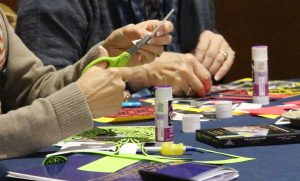
Thursday evening, Native American artist Preston Singletary and his band performed in the Polsky Theatre, which ended up being one of the event’s highlights for Gerety Folk. Singletary is also a successful visual artist.
“We had so much activity going on. [There were] 75 presenters and over 200 people in attendance,” Gerety Folk said. “[We had] 10 visiting artists at any given time in eight different spaces. Some of these spaces were in new buildings and we didn’t know what to expect, but everything turned out well. Every time I saw someone who needed assistance, they got it. Our [technical assistance] here at the college was top notch. I have seen dozens of photos on social media that show people teaching, learning and creating all over the place.”
Art educators from across the state attended the conference. Heather Huettner teaches K-6 at Crestview Elementary School in Shawnee. She has been teaching for 13 years and attends the conference at her own expense. “I have been a member most of my career because I had a mentor teacher and posse of other experienced teachers who took me under their wings and invited me into presenting and such. Also, when I started teaching, I had a supportive district that paid for us to attend…not so much now, but I see the value in getting a fresh wind each fall.”
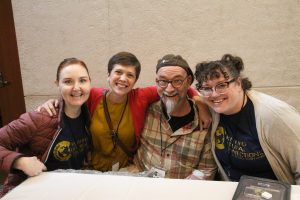
Colby Patton and Casi Short, who teach in Oxford, presented their cross-curricular Spanish-Art program to educators at the conference. Patton said, “I teach at Oxford Junior/Senior High School and teach a 7th grade exploratory Spanish class, Spanish I and II and Teaching as a Career to high school students. Myself and Casi Short created a year-long 7th grade cross-curricular Spanish and Art class that we co-teach. That is the origination of our Hispanic Heritage projects and the current unit that we’re in. Cross-curricular teaching helps reinforce concepts in multiple contexts. In the case of Spanish and Art, I speak as much in Spanish as possible, so the students are learning the language in a natural, immersive setting. They’ll learn the language through comprehensible input, just as anyone could if they were to be dropped into the middle of a non-English speaking country and eventually pick up the native language.”
According to Patton, the impact teachers have on students extends beyond the immediate classroom experiences. She said, “I think the impact we have is [to] the greater community, not just our immediate community. We help the students become more culturally aware of their surroundings and open their horizons to new ways to view the world; this ultimately will help them in whatever community they choose to live in as
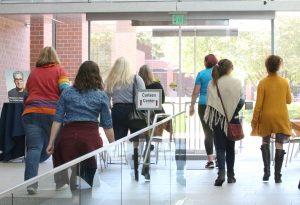
to be under-represented, and I was thrilled to see such diversity at the Nerman! The campus is
beautiful! Art everywhere!” Beth Burns said. Photo courtesy of Penny Thieme.
adults.”
Beth Burns, Newton, teaches Kindergarten through 4th grade at Slate Creek and South Breeze Elementary Schools. Burns said, “I see approximately 520 students each week…There were many workshops to help us find ways to make cultural connections in our own communities (KCKids Unite and the Race Project KC, for example) and the keynote speaker sharing his work and story was amazing.”
Heather Huettner’s favorite part of the conference was, “[having] time to create and converse along like-minded people who ‘get’ what I do every day.” She recommends the conference and finds it educational and rejuvenating.
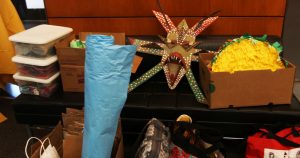
There were over 60 sessions, view the list online.
The theme of this year’s conference was Creating Cultural Connections. Huettner said this of the Nelson Atkins Museum of Art’s presentation, “I learned about the collaborative opportunities that foster unity and understanding across socio-economic boundaries and about some of the systems in place that create division in our communities.”
Having the conference on campus during the 50th Anniversary year added to the excitement and momentum of the college’s cultural influence. Gerety Folk said, “Attendance over 200 is more than the fall conference has seen in the past five years. Shawnee Mission hosted it six years ago and we had 250. More important than numbers though, I had past conference hosts and board members express their gratitude throughout the program. I saw college faculty and administrators from different areas come together. We have some stellar educators in our community, and they had their moment in the spotlight. I tried to make sure presenters had support and they expressed their gratitude. That feels like success to me.”
Huettner said, “JCCC is a great setting for a conference like this. There is so much art on campus that is accessible, and the rooms were accommodating.”
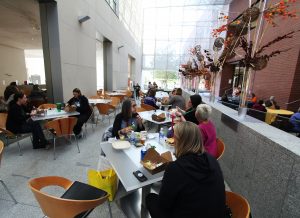
KAEA president Kate Miller, Hiawatha, said she was pleased with the success of the event. Gerety Folk said, “I think our presenters and participants felt validated, reinvigorated and inspired.”
She credits the army of people who made the conference a reality
and went on to say, “My thank-you list includes 13 college employees and eight JCCC student volunteers, plus the 11 committee members who were primarily school teachers working on conference business in their free time. It is a volunteer-run organization. KAEA had about five pre-service teachers volunteering with the sales table. 65 presenters were volunteers from outside the college, and 20 board members are all volunteers.”
Huettner was inspired to think about how she might integrate what she learned from the college faculty in her teaching practice. She said, “I enjoyed hearing the faculty of JCCC discuss their personal art practice and journeys. I am not sure how to implement that in my teaching practice other than to be mindful that all students, including me, come to the art table with variables that direct the journey and experience with the process.”
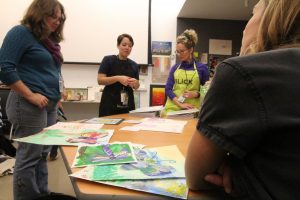
Art is important because it helps us tell our own story, or our collective story,” Burns said. “In my opinion, this is an important way we can share and celebrate how we are the same as well as the things that make us unique. And our story doesn’t end when our lives do. Our art (music, writing, etc.) can go on. “
“My students will be impacted because I came back from the conference with renewed excitement about my field. Meeting and networking with colleagues is so encouraging. Learning new ideas for my classroom and my own art-making renews my soul,” Burns said. “I love sharing the joy of creating and appreciating art. I believe everyone can create some kind of art and that it fulfills a need all humans have. I also believe that thinking creatively is important in every field, and what better place to learn that than in art class?”
Story by Penny Thieme






















